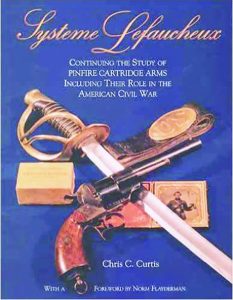Book Review | by Larry S. Sterett |Contributing Editor
 SYSTEME LEFAUCHEUX by Chris C. Curtis. Published by Graphic Publishers, Dept. TGM, PO Box 10787, Santa Ana, CA 92711. Price: $44.95, plus postage. Slightly lower price available from various online book sellers.
SYSTEME LEFAUCHEUX by Chris C. Curtis. Published by Graphic Publishers, Dept. TGM, PO Box 10787, Santa Ana, CA 92711. Price: $44.95, plus postage. Slightly lower price available from various online book sellers.
This oversize 312-page hardbound volume has been needed for years. Endorsed by the Company of Military Historians, it has been around for a while, but is still in print and well worthy of shelf space in any arms owner’s library. The only major prior reference work in English on pinfire ammunition and arms was a 1983 volume The Pinfire System. This went out-of-print in a hurry, and rather do a reprint, the authors decided to do a new, revised and expanded volume on the subject. This “Continuing the Study of Pinfire Cartridge Arms” is the result.
Following an excellent Foreword and the usual preface and acknowledgments, this book features 11 chapters, a bibliography, and an excellent index. Topics covered range from Casimer Lefaucheux: Father of the Pinfire System to Pinfire Cartridges and Reloading Apparatus. (Yes, pinfire cartridges can be reloaded; not as easily as with centerfire cartridges, but it is possible.)
The collecting of pinfire arms—handguns, rifles, and shotguns—has grown tremendously in recent years, although such arms date from prior to the American Civil War. (Lefaucheux invented the pinfire system in 1835, as the fourth addition to his 1833 patent number 5525. A copy of the handwritten application, with drawings, appears in this tome.) The increase in collecting interest has also prompted an increase, unfortunately, in the cost of collecting such arms.
This volume is lavishly illustrated with excellent black and white photographs of all types of pinfire arms, plus patent papers and drawings, correspondence and photos of ammunition, Civil War soldiers carrying pinfire arms, advertisements for pinfire arms, etc. Even the tiny 2mm “charm pistols” are illustrated and discussed
Several of the chapters feature endnotes, tables, etc. At the end of Chapter Seven—Identifying and Collecting Pinfire Arms—there’ a Pinfire Arms Rarity and Desirability Chart. This chart ranks the various pinfires in ten levels from the Most Common Types to the Rarest Types, with the latter including any arms made by Casimir Lefaucheux himself. LeMat revolvers and rifles are classed in Levels 8 and 9, respectively, as are the combination sword-pistols, etc., and the (unusual double-cylinder) 20-shot revolvers. (Overall, nearly five dozen types of pinfire arms are listed in this chart.)
Chapter Seven, in addition to photos and text, also features five pages of illustrations, with comments, and proofmarks found on assorted pinfire arms. Proofmarks featured include those from Belgium, France, England, Germany, and Spain. This definitely makes researching a specific pinfire arm much easier.
The well-illustrated final chapter, devoted to reloading, contains tables of American and British pinfire cartridge patents, plus three complete pages featuring nearly six dozen different pinfire cartridge headstamp illustrations. Explanatory captions are provided for each illustration.
The bibliography in this tome is excellent, but the index is great. All the known patents relating to pinfires are listed in numerical order by country.
What was the largest pinfire firearm produced? Good question, but an incomplete answer, I would hazard. However, a No. 2 pinfire punt gun manufactured in Birmingham, England, sometime between 1855 and 1876, is illustrated. It weighs 130 pounds and measures 9 feet, 4 inches overall. Charge for the 1.325-inch bore ranged from 6 ounces to 1½ pounds of BB or No. 1 shot ahead of an equal volume (not weight) of large grain blackpowder. Imagine touching off the trigger on this gem!
This volume has to be the bible on the subject of pinfire arms and ammunition. It is thorough, and extremely well illustrated. It deserves shelf space with the reference volumes of any arms collector, museum curator, ammunition collector, antique arms dealer or firearms enthusiast.



